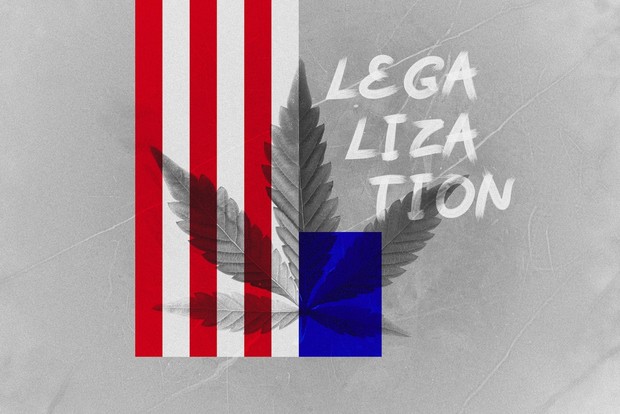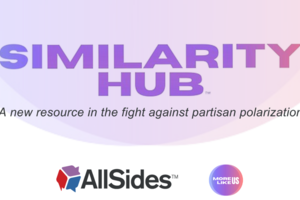What Is the Impact of Legalized Marijuana at the State Level?

This piece was originally published by Divided We Fall (Mixed). It was written by Karen O’Keefe, Director of State Policies, Marijuana Policy Project, Jaime Zerbe, Chief of Staff, Smart Approaches to Marijuana, and Lauren Bratcher, Deputy Director, Kentucky NORML.
By Karen O’Keefe – Director of State Policies, Marijuana Policy Project
National polls have made it clear that a strong majority of Americans are in favor of ending the prohibition on cannabis. More than two-thirds of Americans support legalizing cannabis for adults and 93% of US voters think cannabis should be legal for medical use, including 85% of Republicans and more than 95% of Democrats and independents. And yet, the federal government remains intensely hostile to cannabis.
The federal government’s failed war on cannabis has led to decades of injustice and devastating consequences. More than 17 million Americans have been arrested for cannabis since 1995—resulting in trauma, interrupted lives, family separation, dreams derailed by the scarlet letter of a record, and even deaths in jail. Over 40,000 individuals remain behind bars for cannabis-related charges.
Under federal law, cannabis is a Schedule I drug, meaning that it is treated as one of the most serious and deadly drugs we have despite ample evidence to the contrary. In fact, the American Medical Association called on the federal government to reconsider cannabis’ status as a Schedule I drug in 2009, noting clinical trials have shown cannabis’ medical efficacy. A Schedule I status not only criminalizes cannabis at the federal level, but it also unnecessarily blocks research into cannabis’ use as a medicine, creating a perfect Catch-22. Federal officials say marijuana isn’t a medicine because the FDA hasn’t approved it while making sure that the studies needed for FDA approval never happen.
While the federal government continues to enforce prohibition despite widespread support for medical and adult-use legalization, a vast majority of states have heeded the will of the people and reformed cannabis laws. Because Congress and the DEA have failed to make medical cannabis legal, 38 states and Washington, D.C. have enacted their own laws to protect patients and now have workable medical cannabis laws on the books.
Furthermore, 23 states have passed laws to legalize and regulate cannabis for adult use and are reaping the benefits. These states have seen fewer cannabis arrests, increased tax revenues, and more jobs. Legalization has helped to displace the illegal market and freed up law enforcement resources to focus on serious crime. Considering this, it comes as no surprise that voters in states that have implemented legalization overwhelmingly view the laws as successful.
While there is growing evidence of the broad and transformative benefits of cannabis reform in states across the country, misinformation and scare tactics remain very real obstacles. Opponents of replacing cannabis prohibition with sensible laws and regulations frequently make claims that sound alarming. However, upon closer examination, their key sources lack credibility and distort the truth.
For example, one of the most perpetuated myths is that legalization leads to increased teen use of cannabis. But according to the CDC’s Youth Risk Behavior Survey, even as more states have legalized cannabis over the past decade, teen cannabis consumption rates are now at a record low. As the head of the federal National Institute on Drug Abuse (NIDA), Nora Volkow, testified in the US Senate in March of 2021, “Specifically in the United States, legalization by some states of marijuana has not been associated with an increase in adolescents’ marijuana use.” This is unsurprising since illicit cannabis sellers have no incentive to ask for ID while licensed businesses have a huge incentive to do so.
The Centennial Institute’s report, which purports to show that legalization has imposed enormous costs on the state of Colorado, has been strongly criticized for its “laughably bad” methodology. Paul Danish, writing at Boulder Weekly, described the study as “a dog’s dinner of statistical scraps that run the gamut from misleading to dishonest, irrelevant and embarrassing.” For example, the bulk of the study’s cited costs of legalization in Colorado result from a supposed increase in dropout rates. In reality, teens’ cannabis use hasn’t increased, and graduation rates are up.
The truth is that cannabis prohibition has been a costly policy failure with a significant human toll. Just like alcohol prohibition, cannabis prohibition does not eliminate the use of the product and simply steers all of the profits to the underground market. We need a cannabis policy that reflects the realities of cannabis and minimizes the harm surrounding it. Cannabis is relatively safe for responsible adult use, it is widely available and commonly used, and it’s not going anywhere anytime soon.
Legalizing and regulating cannabis is the most realistic and effective alternative to prohibition. Under such a system there would be a strictly enforced legal age limit for purchasing and using cannabis; cannabis and cannabis-infused products would be produced, distributed, and tested by state-licensed businesses; adults of legal age would be permitted to grow limited amounts of cannabis for personal use (similar to home-brewing); and cannabis would be subject to local and state sales taxes, as well as reasonable excise taxes established by voters or their elected representatives.
By Jaime Zerbe – Chief of Staff, Smart Approaches to Marijuana
The movement to legalize marijuana is championed by a profit-driven industry at the expense of public health and safety. The industry often first targets states for medical legalization, then moves to recreational legalization. Take it from the founder of the National Organization for Reform of Marijuana Laws (NORML), Keith Stroup, who once said, “We are trying to get marijuana reclassified medically. If we do that…[we] will be using the issue as a red herring to give marijuana a good name.”
As a country, we do not vote on what is or is not medicine. Potential medicines should go through the FDA’s standard development and approval process and be viewed through the lens of safety and efficacy. The FDA has approved a handful of medications containing cannabinoids. They are available via prescription for certain conditions, including seizures, nausea, and loss of appetite. This process works.
However, the legalization of medical marijuana is not related to these approved medications. Crude marijuana has failed the scientific review process and remains a Schedule I substance—meaning it has a high potential for abuse and no accepted medical use—and it has not been regulated or approved by the FDA. It is driven by an industry that stands to make billions from future sales.
The commercial medical marijuana market has raced ahead of the science on marijuana’s efficacy in treating several ailments, including chronic pain and mental health issues. In spite of evidence that a lower THC dosage is more appropriate for medical purposes, medical marijuana products often contain the same concentration of THC as recreational marijuana products, sometimes two to three times the concentration of what could best alleviate pain.
Many companies that are licensed to sell medical marijuana are also licensed to sell recreational marijuana. This overlap is deliberate, and the public health and public safety consequences of medical and recreational legalization are often indistinguishable. States that legalize marijuana see higher rates of use, including youth use, higher rates of THC-involved car crashes, more THC-related poison control calls, and higher rates of hospitalizations and ER visits.
These negative public health outcomes have human and financial costs. Legalization does not result in an influx of cash for states. In fact, for every $1 in tax revenue from marijuana sales, Colorado spends $4.50 offsetting these negative costs of legalization.
The legalization and commercialization of marijuana have incentivized this profit-driven industry to create more potent products that are more addictive. The marijuana flower smoked in the 1970s averaged between 1% and 5% THC, whereas today’s averages are between 15% and 20% THC. Concentrates and edibles can reach 99% THC. Users, particularly kids, are getting high off products that didn’t even exist when they were born.
This higher potency has contributed to higher rates of dependence. According to the National Survey on Drug Use and Health, 31% of past-year marijuana users meet the criteria for a cannabis use disorder, also known as addiction to marijuana. Users of high-potency marijuana are four times more likely than users of low-potency products to become addicted. Daily users of marijuana above 10% THC are nearly five times more likely to develop psychosis than non-users. The National Institute on Drug Abuse warned, “The risks of physical dependence and addiction increase with exposure to high concentrations of THC, and higher doses of THC are more likely to produce anxiety, agitation, paranoia, and psychosis.”
Legalization has yet to deliver on any of its promises, including the advancement of racial equity. According to the ACLU, “racial disparities still remained” following legalization. In some states, the disparity worsened after legalization or decriminalization. Additionally, despite claims that it will empower racial minorities, less than 2% of owners in the marijuana industry are Black.
Legalization also exacerbates the illicit market. In a series published by the Los Angeles Times, reporters found that illegal grows outnumber legal grows in California by as much as 10 to 1. Not only do these illegal grows rely on trafficked workers for labor, but they also ignore environmental regulations, including pesticide limits and water restrictions. This isn’t just affecting the illicit market: an estimated 70–80% of marijuana sold in California’s legal dispensaries is illegally grown and produced.
As we have seen in the states that have experimented with it, marijuana legalization has failed to live up to its promises. Instead, we have witnessed the expansion of an industry that has produced and promoted ever-stronger products, resulting in unprecedented rates of use and dependence. Rather than incentivizing an addiction-for-profit industry, we should invest in treatment, prevention, and supply reduction, which aim to discourage marijuana use and help more Americans live healthy, drug-free lives.
By Lauren Bratcher – Deputy Director, Kentucky NORML
The legalization of medical cannabis has been a topic of debate in the United States for years. Advocates argue that medical cannabis provides a safe and effective treatment option for patients suffering from various medical conditions while opponents claim that it is a gateway drug and that its legalization will lead to increased drug use and addiction. With the passing of SB 47 in Kentucky, the state has taken a significant step forward in the ongoing debate around the use of medical cannabis.
One of the primary benefits of legalizing medical cannabis is the relief it can provide for patients who have been unable to find effective treatments through traditional medications. Medical cannabis has been shown to alleviate pain, reduce nausea and vomiting, stimulate appetite, and improve sleep for patients with various medical conditions. For many patients, medical cannabis has been a life-changing treatment option that has significantly improved their quality of life.
The legalization of medical cannabis also has significant economic benefits. In states where medical cannabis has been legalized, the industry has generated significant tax revenue and created new job opportunities. Kentucky is expected to benefit from similar economic growth, particularly in the areas of cultivation, distribution, and retail. The creation of a legal medical cannabis industry could also reduce healthcare costs for the state, as patients may be able to rely less on expensive prescription medications.
Opponents of medical cannabis argue that it is a gateway drug and that legalizing it will lead to increased drug use and addiction. While it is true that some individuals may abuse medical cannabis, it is important to note that it can only be obtained through a doctor’s prescription and can only be used for legitimate medical purposes. Additionally, studies have shown that states that have legalized medical cannabis have not seen an increase in drug use or addiction rates. Thus, by legalizing medical cannabis, Kentucky has provided a safe and effective treatment option for patients in need while also creating new job opportunities and generating tax revenue.
Another concern around the legalization of medical cannabis is the potential for impaired driving. It is important for the state to carefully regulate the industry to ensure that medical cannabis is only used for legitimate medical purposes and does not contribute to public health concerns such as impaired driving or increased marijuana use among young people. The state must also address concerns around the stigma associated with medical cannabis use, which may prevent some patients from seeking out this treatment option.
Moving forward, it will be important for the state to carefully monitor and regulate the medical cannabis industry to ensure that it is functioning appropriately. This will require cooperation between lawmakers, medical professionals, and industry leaders to create a system that works for everyone. By doing so, Kentucky can continue to provide a safe and effective treatment option for patients in need while also reaping the economic benefits of the medical cannabis industry.
The passing of SB 47 in Kentucky is a significant development in the ongoing debate around the legalization of medical cannabis in the United States. While there are valid concerns around the regulation and potential misuse of medical cannabis, it is important to acknowledge the significant benefits it can provide for patients and the economy. By legalizing medical cannabis, Kentucky has taken a step forward in providing safe and effective treatment options for patients in need while also stimulating economic growth in the state. With careful regulation and monitoring, the medical cannabis industry in Kentucky can provide a model for other states considering legalization.

April 26th, 2024

April 25th, 2024

April 25th, 2024